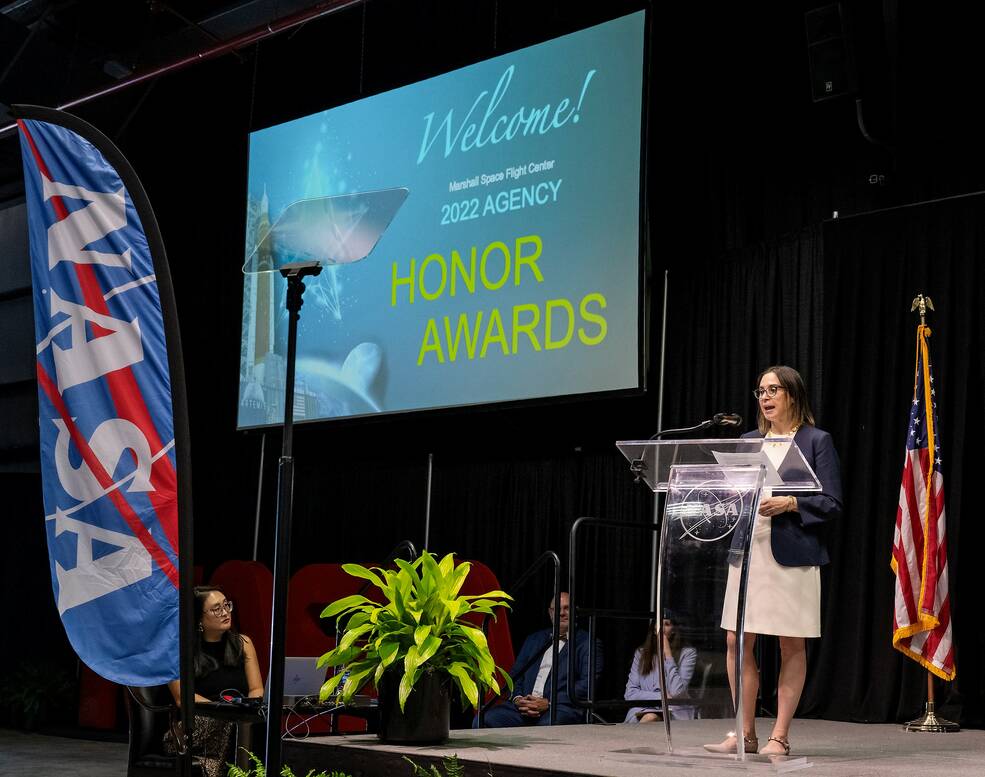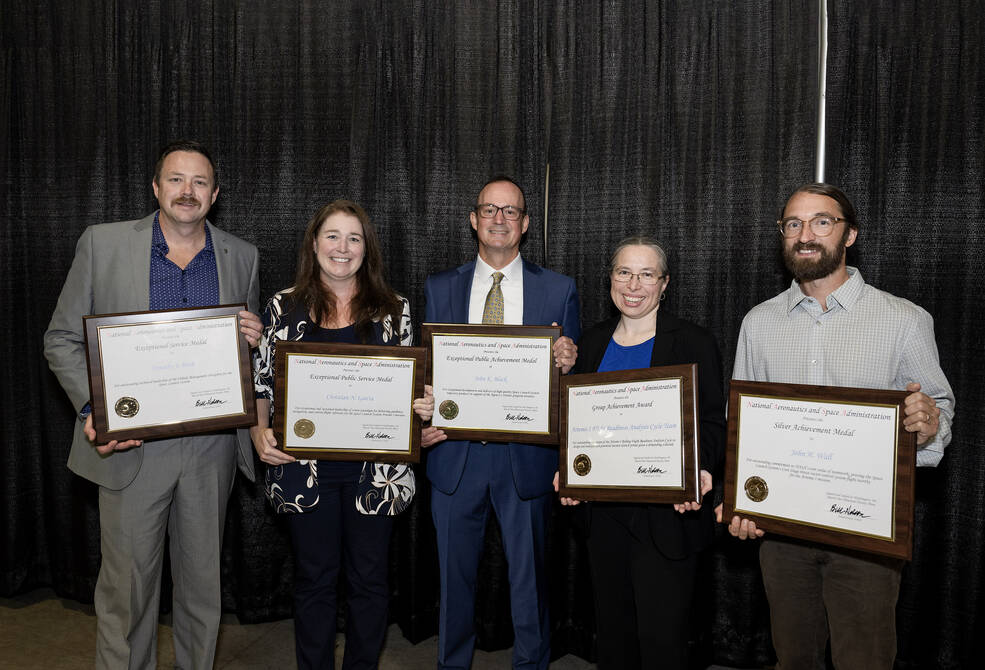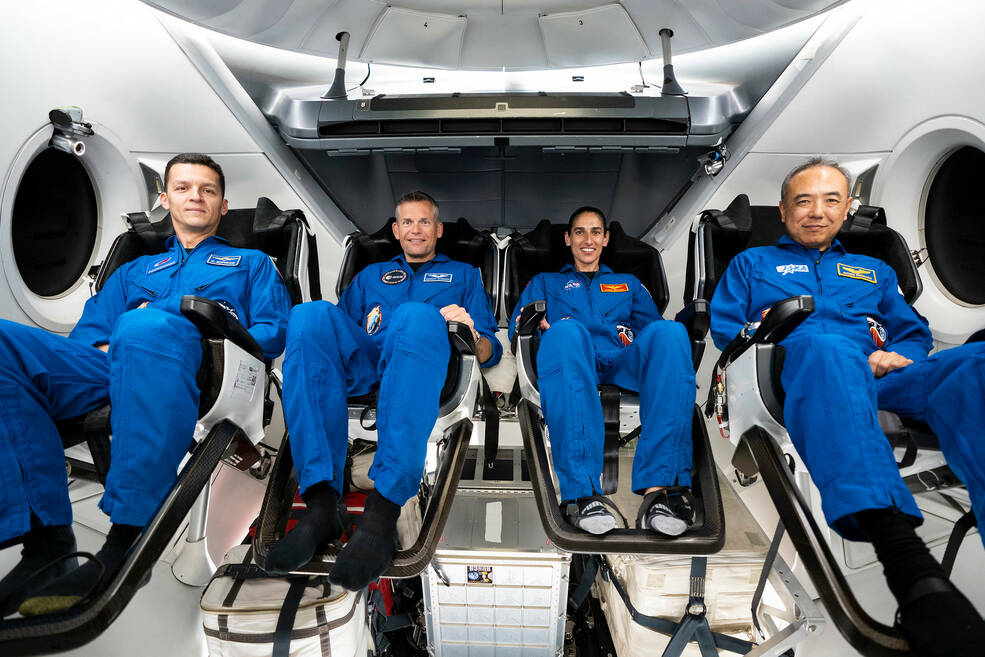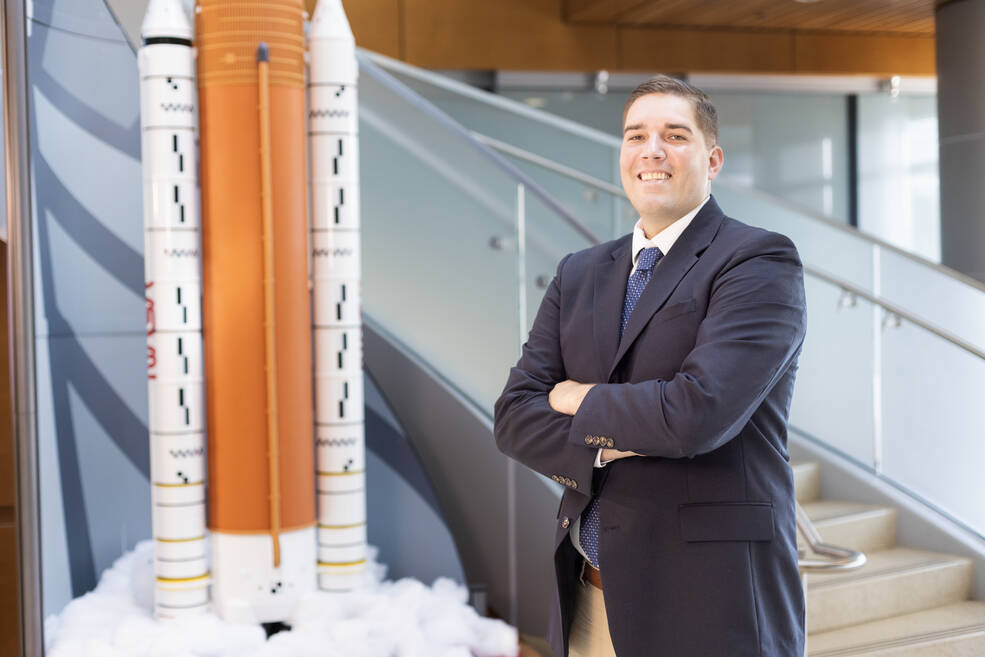The Marshall Star for August 23, 2023.
In This Week’s Star
- Agency Honor Awards Ceremony Recognizes Center Team Members
- Coverage Set for NASA’s SpaceX Crew-7 Events, Broadcast, Launch
- SLS Hardware for Artemis III Mission Arrives in Florida
- I Am Artemis: Cody Jones
- Chandra: A Giant Black Hole Destroys a Massive Star
- New Video Series Reveals What Drives NASA’s Psyche Mission Team
- ALOFT Field Campaign Featured on ‘This Week at NASA’
- Webb Reveals Intricate Details in the Remains of a Dying Star
Agency Honor Awards Ceremony Recognizes Center Team Members
NASA’s Marshall Space Flight Center held its 2022 Agency Honor Awards Ceremony Aug. 16 in Activities Building 4316 to recognize Marshall team members for their outstanding accomplishments and exceptional contributions to NASA missions.
The ceremony included remarks from Acting Center Director Joseph Pelfrey, followed by a keynote address from Dr. Makenzie Lystrup, director, NASA’s Goddard Space Flight Center.
The event continued with presenting the agency honor awards. Find out who all the recipients are in this program from the ceremony.
Coverage Set for NASA’s SpaceX Crew-7 Events, Broadcast, Launch
NASA will provide coverage of the upcoming prelaunch and launch activities for the agency’s SpaceX Crew-7 mission with astronauts to the International Space Station.
The launch is targeted for 2:49 a.m. CDT on Aug. 25, from Launch Complex 39A at NASA’s Kennedy Space Center. The Dragon spacecraft, named Endurance, is scheduled to dock to the space station at 1:02 a.m. CDT on Aug. 26.
Crew arrival, launch, the postlaunch news conference, and mission coverage through docking will air live on NASA Television, the NASA app, and the agency’s website. NASA also will host an audio-only post-Flight Readiness Review news teleconference. Follow all live events.
The Crew-7 launch will carry NASA astronaut Jasmin Moghbeli, ESA (European Space Agency) astronaut Andreas Mogensen, JAXA (Japan Aerospace Exploration Agency) astronaut Satoshi Furukawa, and Roscosmos cosmonaut Konstantin Borisov.
As part of the agency’s Commercial Crew Program, Crew-7 marks the eighth human spaceflight mission supported by a SpaceX Dragon spacecraft and the seventh crew rotation mission to the space station since 2020 for NASA. A team of about 200 people at NASA’s Marshall Space Flight Center work in support of the Commercial Crew Program.
Progress Cargo Craft Successfully Launches to Station
The uncrewed Roscosmos Progress 85 spacecraft is safely in orbit headed for the International Space Station following launch at 8:08 p.m. CDT on Aug. 22 from the Baikonur Cosmodrome in Kazakhstan. The resupply ship reached preliminary orbit and deployed its solar arrays and navigational antennas as planned on its way to meet up with the orbiting laboratory and its Expedition 69 crew members.
Progress will dock to the aft port of the Zvezda service module about 10:50 p.m. CDT on Aug. 24. Coverage of rendezvous and docking will begin at 10 p.m. on the NASA Television Media Channel and the agency’s website. Progress will deliver almost three tons of food, fuel, and supplies to the space station.
SLS Hardware for Artemis III Mission Arrives in Florida
The upper stage for NASA’s SLS (Space Launch System) rocket that will power the agency’s Artemis III mission and send astronauts on to the Moon for a lunar landing arrived at the Cape Canaveral Space Force Station Poseidon Wharf in Florida on Aug. 9.
It will undergo final checkouts by contractors Boeing and ULA (United Launch Alliance) at ULA’s facilities before it is delivered to NASA’ s nearby Kennedy Space Center.
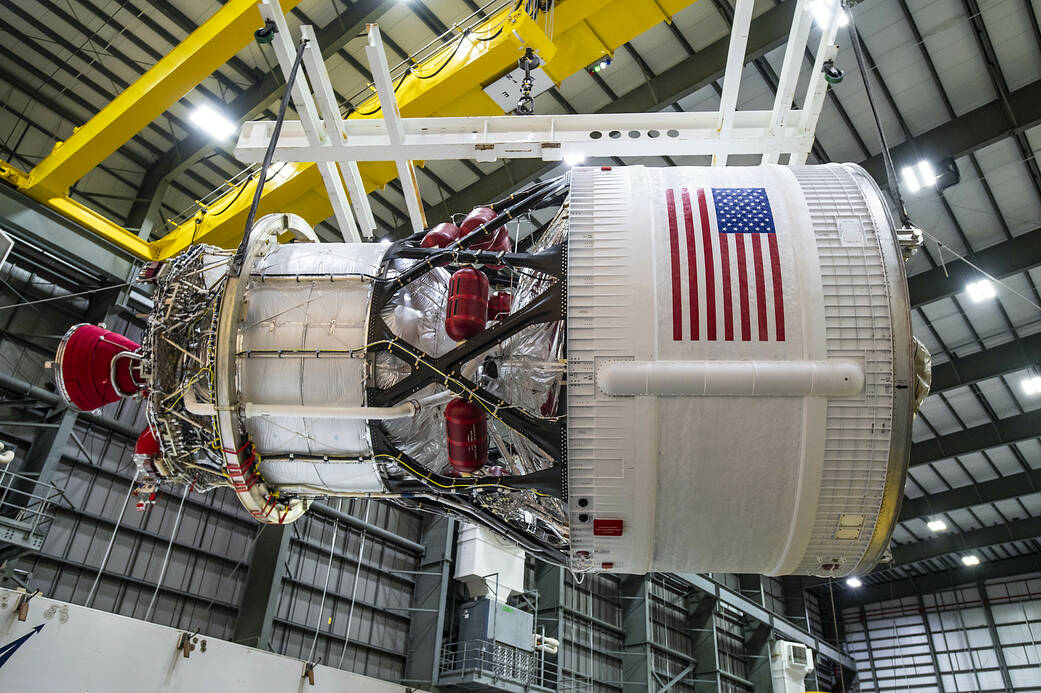
The SLS rocket’s ICPS (interim cryogenic propulsion stage) with its single RL10 engine is responsible for giving NASA’s Orion spacecraft and astronauts inside the big push needed to journey to the Moon in a precise trajectory during Artemis III.
The ICPS for the mission is the last of its kind as Artemis missions beginning with Artemis IV will use the SLS Block 1B configuration with its more powerful exploration upper stage for launch and flight. Manufactured by ULA, the ICPS left Decatur, Alabama on Aug. 1, traveling down the Mississippi River and along the Gulf Coast toward ULA’s Florida facility via ULA’s RocketShip. The RL10 engine is produced by Aerojet Rocketdyne, the SLS engines’ lead contractor, in West Palm Beach, Florida. NASA’s Marshall Space Flight Center manages the SLS Program.
I Am Artemis: Cody Jones
When Cody Jones graduated with a degree in communication arts from UAH (University of Alabama in Huntsville) in 2011, he had no idea what he was supposed to do next.
“I graduated with my degree in a place named the Rocket City, but I never imagined myself as someone who would work with rockets,” Jones said.
However, a professor saw Cody’s potential and suggested he apply for an internship working as a payload communicator in the International Space Station Payload Operations and Integration Center at NASA’s Marshall Space Flight Center. Although the position was intended for someone with a technical background, Jones’ communication skills, persistence, and willingness to learn about the aerospace industry got him the job and helped make him successful in that initial role. It led him to his current one as project manager for the ICPS (interim cryogenic propulsion stage) for NASA’s SLS (Space Launch System) Program, which is managed by Marshall, and will help NASA land the first woman and first person of color on the Moon under Artemis.
The ICPS, produced by Boeing and United Launch Alliance, is the in-space propulsion stage of the SLS rocket for the first three Artemis missions. Its single RL10 engine, made by lead SLS engines contractor Aerojet Rocketdyne, produces more than 24,750 pounds of thrust to help send Orion and its crew on their journey to the Moon. During the successful Artemis I test flight in 2022, the ICPS propelled NASA’s Orion spacecraft toward the Moon after the rocket’s core stage and solid rocket boosters were spent. The stage will help play a critical role during Artemis III, which will land astronauts on the surface of the Moon by giving Orion the big propulsive boost needed to break free from Earth orbit and venture toward the Moon.
Jones described his position as a complicated game of telephone.
“I deliver messages across the program to different tiers of individuals, but along the way I try to prevent the message from getting watered down,” Jones said. “I also work with the contracting partners to ensure that our team at Marshall has the resources and help that they need.”
In addition to delivering crucial information with clarity, Jones is responsible for visiting numerous manufacturing sites. The ICPS is made up of more than 6,500 components that require testing and review before being integrated with the stage.
“I review every last detail to make sure that the hardware we’re adding meets the requirement,” Jones said. He also enjoys the relational aspect of his position: “My goal is to make everyone feel comfortable to ask whatever they want so that they get the answers they need, while also having a memorable experience.”
Jones said his dream job is his current role – helping to return astronauts to the Moon through Artemis.
“I feel like we’ve all worked jobs where we’re not sure if what we do matters. At the end of the day, are we part of the story?” Jones mused. “When I witnessed the launch of Artemis I, I immediately felt like I was part of the story, and everyone around me was, too.”
As a father of three, Jones said he looks forward to watching his own children grow up as part of the story of the Artemis Generation.
Check out some other “I am Artemis” features.
Chandra: A Giant Black Hole Destroys a Massive Star
Astronomers have made a thorough forensic study of a star that was torn apart when it ventured too close to a giant black hole and then had its insides tossed out into space.
NASA’s Chandra X-ray Observatory and ESA’s XMM-Newton studied the amount of nitrogen and carbon near a black hole known to have torn apart a star. Astronomers think these elements were created inside the star before it was ripped apart as it neared the black hole.
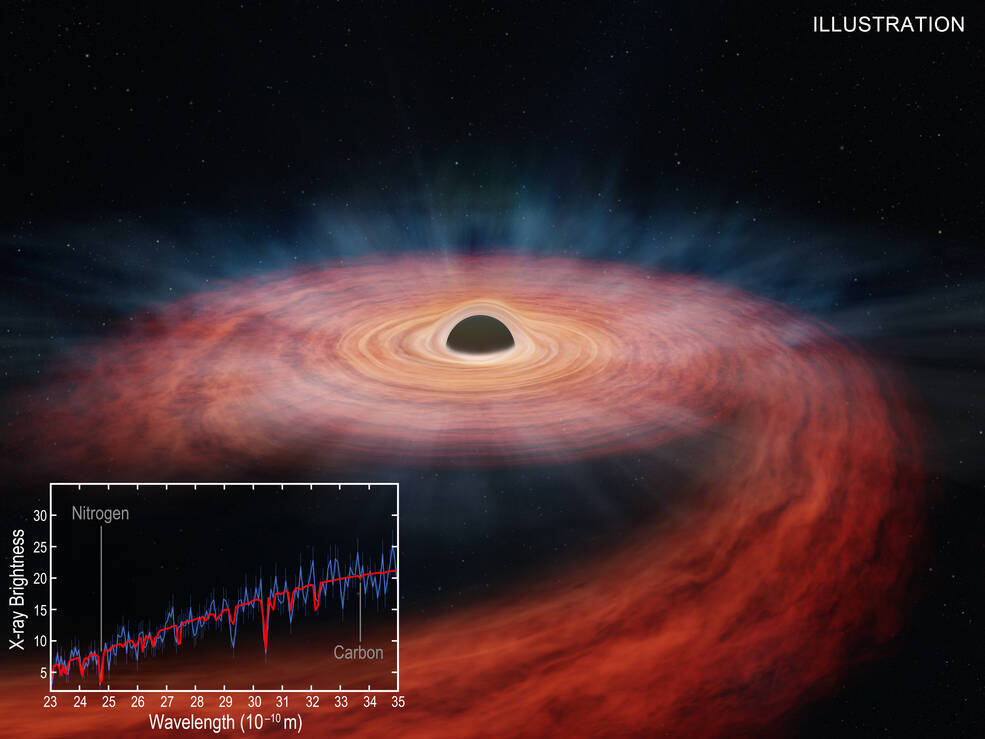
“We are seeing the guts of what used to be a star,” said Jon Miller of the University of Michigan who led the study. “The elements left behind are clues we can follow to figure out what sort of star met its demise.”
Astronomers have found many examples of “tidal disruption events” in recent years, where the gravitational forces from a massive black hole destroy a star. This causes a flare, often seen in optical and ultraviolet light and X-rays, as the star’s debris is heated up. This event, called ASASSN-14li, stands out for several reasons.
At the time of discovery in November 2014 it was the closest tidal disruption to Earth (290 million light-years) discovered in about a decade. Because of this proximity, ASASSN-14li has provided an extraordinary level of detail about the destroyed star. Miller’s team applied new theoretical models to make improved estimates, compared to previous work, of the amount of nitrogen and carbon around the black hole.
“These X-ray telescopes can be used as forensic tools in space,” said co-author Brenna Mockler of Carnegie Observatories and the University of California, Los Angeles. “The relative amount of nitrogen to carbon that we found points to material from the interior of a doomed star weighing about three times the mass of the Sun.”
The star in ASASSN-14li is therefore one of the most massive – and perhaps the most massive – that astronomers have seen ripped apart by a black hole to date.
“ASASSN-14li is exciting because one of the hardest things with tidal disruptions is being able to measure the mass of the unlucky star, as we have done here,” said co-author Enrico Ramirez-Ruiz of the University of California, Santa Cruz. “Observing the destruction of a massive star by a supermassive black hole is spellbinding because more massive stars are expected to be significantly less common than lower-mass stars.”
Earlier this year, another team of astronomers reported the “Scary Barbie” event where they estimated a star with about 14 times the mass of the Sun was destroyed by a black hole. However, this has not yet been confirmed as a tidal disruption, with the estimate of the star’s mass mainly based on the brightness of the flare, not on a detailed analysis of material around the black hole as with ASASSN-14li.
Another exciting aspect of the ASASSN-14li result is what it means for future studies. Astronomers have seen moderately massive stars like ASASSN-14li’s in the star cluster that contains the supermassive black hole in the center of our galaxy. Therefore, the ability to estimate stellar masses of tidally disrupted stars potentially gives astronomers a way to identify the presence of star clusters around supermassive black holes in more distant galaxies.
Until this study there was a strong possibility that the elements observed in X-rays might have come from gas released in previous eruptions from the supermassive black hole. The pattern of elements analyzed here, however, appears to have come from a single star.
Previous work published in 2017 by Chenwie Yang from the University of Science and Technology in Hefei, China, used ultraviolet data from NASA’s Hubble Space Telescope to show that there is enhanced nitrogen compared to carbon in ASASSN-14li, but by a smaller amount than Miller’s team found using X-ray data. Those authors found the star to be only more massive than 0.6 times that of the Sun.
The new paper was published in the August 20, 2023, issue of The Astrophysical Journal Letters. The other authors of the paper, in addition to Miller, Mockler, and Ramirez-Ruiz, are Paul Draghis (University of Michigan), Jeremy Drake (Center for Astrophysics | Harvard & Smithsonian), John Raymond (CfA), Mark Reynolds (University of Michigan), Xin Xiang (University of Michigan), Sol Bin Yun (University of Michigan), and Abderahmen Zoghbi (University of Maryland).
NASA’s Marshall Space Flight Center manages the Chandra program. The Smithsonian Astrophysical Observatory’s Chandra X-ray Center controls science operations from Cambridge, Massachusetts, and flight operations from Burlington, Massachusetts.
New Video Series Reveals What Drives NASA’s Psyche Mission Team
What motivates someone to labor for years to help build something that will be rocketed into space, never to be seen again on our planet? For the scientists, engineers, and technicians behind NASA’s Psyche mission to a metal-rich asteroid, the answers are wide-ranging but share a common thread: a passion to explore the unknown.
That inspiration is highlighted in the new “Behind the Spacecraft” video series, in which five members of the Psyche team tell the story of how they ended up on a mission designed to answer questions about the mysterious asteroid Psyche.
- Christina Hernandez, a flight systems engineer at NASA’s Jet Propulsion Laboratory, helped guide the team through the verification-and-validation phase of the mission to ready the spacecraft for the extreme conditions of space. For her, engineering is a way to make science fiction reality. And as a heavy metal fan, she’s excited that Psyche is a mission bound for a metal world.
- Meena Sreekantamurthy, a power electronics engineer at the Johns Hopkins Applied Physics Laboratory, worked on the power supply unit for one of the spacecraft’s science instruments. She paints and draws in her free time and marvels that something she helped build with her own hands will reach the asteroid belt.
- Ben Inouye is an engineer who worked on the team that designed and built the spacecraft power system. Before coming to JPL, which manages the mission, he worked as a marine engineer. Now he draws a line from the discoveries made at sea to those that the Psyche mission’s robotic quest hopes to make.
- Julie Li oversaw development of the spacecraft’s sci-fi-worthy solar electric propulsion hardware at Maxar Technologies. As a child, she wanted to be an astronaut, and her first job after college was as a design engineer on NASA’s space shuttle. Today, the spacecraft builder is also an outdoor adventurer.
- Luis Dominguez is the systems and electrical lead at JPL for the assembly, test, and launch operations phase of the mission. As someone who never imagined as a child that he’d be an engineer working somewhere like JPL, he urges the kids he meets to embrace their curiosity. (The video featuring Dominguez will also be available in Spanish.)
Produced by NASA 360, the videos will be released weekly on Tuesdays, with the first one released Aug. 22. JPL will host a livestream with Julie Li at noon CDT on Sept. 13 and one with Luis Dominguez at noon CDT on Sept. 20 on JPL YouTube, Facebook, and X. Questions can be submitted via the livestream chats.
Psyche is set to launch atop a SpaceX Falcon Heavy from Launch Complex 39A at Kennedy Space Center at 9:38 a.m. CDT on Oct. 5, with additional opportunities scheduled through Oct. 25.
Measuring about 173 miles at its widest point, the asteroid Psyche may be the partial core of a planetesimal (one of the building blocks of a rocky planet), or it could be primordial material that never melted. The Psyche mission aims to find out, and to help answer fundamental questions about Earth’s own metal core and the formation of our solar system. Once the spacecraft reaches Psyche in the main asteroid belt between Mars and Jupiter in 2029, it will spend at least 26 months orbiting its target, gathering images and other data that will tell scientists more about the asteroid’s history and what it is made of.
Arizona State University leads the Psyche mission. A division of Caltech in Pasadena, JPL is responsible for the mission’s overall management, system engineering, integration and test, and mission operations. Maxar Technologies in Palo Alto, California, provided the high-power solar electric propulsion spacecraft chassis.
JPL also is providing a technology demonstration instrument called Deep Space Optical Communications that will fly on Psyche in order to test high-data-rate laser communications that could be used by future NASA missions.
Psyche is the 14th mission selected as part of NASA’s Discovery Program, managed by the agency’s Marshall Space Flight Center.
ALOFT Field Campaign Featured on ‘This Week at NASA’
Researchers with the ALOFT project have been using NASA’s high-flying ER-2 aircraft to help them study lightning and its connection to the vast energy fields in our atmosphere. The activity is featured in “This Week @ NASA,” a weekly video program broadcast on NASA-TV and posted online.
The ER-2 can fly above and as close to thunderclouds as safely possible to observe gamma-ray activity within thunderclouds and collect detailed data that can advance the study of high-energy radiation emissions from thunderstorms. The campaign included researchers from NASA’s Marshall Space Flight Center. Read more about Marshall’s involvement.
View this and previous episodes at “This Week @NASA” on NASA’s YouTube page.
Webb Reveals Intricate Details in the Remains of a Dying Star
NASA’s James Webb Space Telescope obtained images of the Ring Nebula, one of the best-known examples of a planetary nebula. Much like the Southern Ring Nebula, one of Webb’s first images, the Ring Nebula displays intricate structures of the final stages of a dying star. Below, Roger Wesson from Cardiff University talks more about this phase of a Sun-like star’s stellar lifecycle and how Webb observations have given him and his colleagues valuable insights into the formation and evolution of these objects, hinting at a key role for binary companions.
“Planetary nebulae were once thought to be simple, round objects with a single dying star at the center. They were named for their fuzzy, planet-like appearance through small telescopes. Only a few thousand years ago, that star was still a red giant that was shedding most of its mass. As a last farewell, the hot core now ionizes, or heats up, this expelled gas, and the nebula responds with colorful emission of light. Modern observations, though, show that most planetary nebulae display breathtaking complexity. It begs the question: how does a spherical star create such intricate and delicate non-spherical structures?
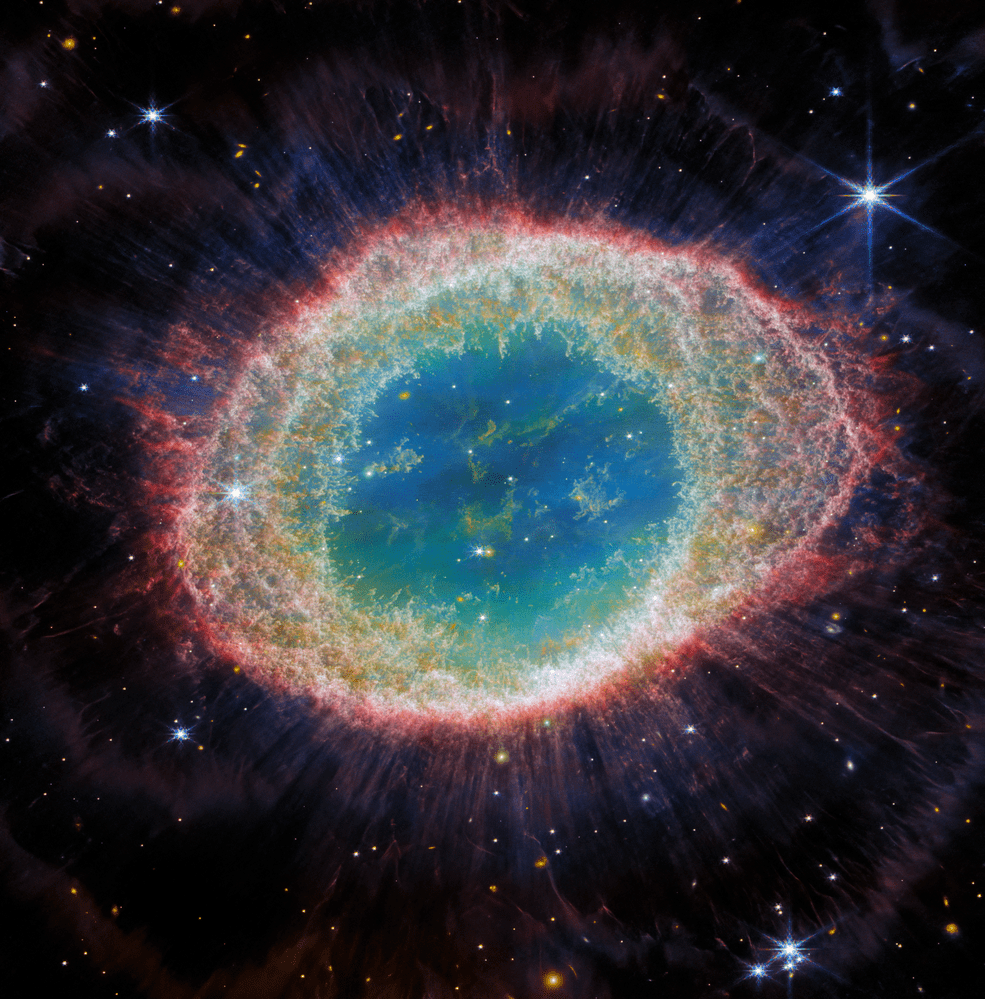
“The Ring Nebula is an ideal target to unravel some of the mysteries of planetary nebulae. It is nearby, approximately 2,200 light-years away, and bright – visible with binoculars on a clear summer evening from the northern hemisphere and much of the southern. Our team, named the ESSENcE (Evolved StarS and their Nebulae in the JWST Era) team, is an international group of experts on planetary nebulae and related objects. We realized that Webb observations would provide us with invaluable insights, since the Ring Nebula fits nicely in the field of view of Webb’s NIRCam (Near-Infrared Camera) and MIRI (Mid-Infrared Instrument) instruments, allowing us to study it in unprecedented spatial detail. Our proposal to observe it was accepted (General Observers program 1558), and Webb captured images of the Ring Nebula just a few weeks after science operations started on July 12, 2022.
“When we first saw the images, we were stunned by the amount of detail in them. The bright ring that gives the nebula its name is composed of about 20,000 individual clumps of dense molecular hydrogen gas, each of them about as massive as the Earth. Within the ring, there is a narrow band of emission from polycyclic aromatic hydrocarbons, or PAHs – complex carbon-bearing molecules that we would not expect to form in the Ring Nebula. Outside the bright ring, we see curious “spikes” pointing directly away from the central star, which are prominent in the infrared but were only very faintly visible in Hubble Space Telescope images. We think these could be due to molecules that can form in the shadows of the densest parts of the ring, where they are shielded from the direct, intense radiation from the hot central star.
“Our MIRI images provided us with the sharpest and clearest view yet of the faint molecular halo outside the bright ring. A surprising revelation was the presence of up to ten regularly spaced, concentric features within this faint halo. These arcs must have formed about every 280 years as the central star was shedding its outer layers. When a single star evolves into a planetary nebula, there is no process that we know of that has that kind of time period. Instead, these rings suggest that there must be a companion star in the system, orbiting about as far away from the central star as Pluto does from our Sun. As the dying star was throwing off its atmosphere, the companion star shaped the outflow and sculpted it. No previous telescope had the sensitivity and the spatial resolution to uncover this subtle effect.
“So how did a spherical star form such a structured and complicated nebulae as the Ring Nebula? A little help from a binary companion may well be part of the answer.”
The James Webb Space Telescope is the world’s premier space science observatory. Webb is solving mysteries in our solar system, looking beyond to distant worlds around other stars, and probing the mysterious structures and origins of our universe and our place in it. Webb is an international program led by NASA with its partners, ESA (European Space Agency) and the Canadian Space Agency. Several NASA centers contributed to the project, including NASA’s Marshall Space Flight Center.


























